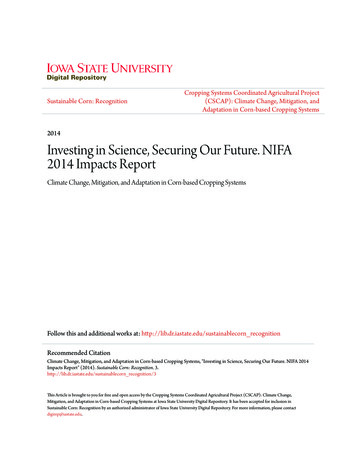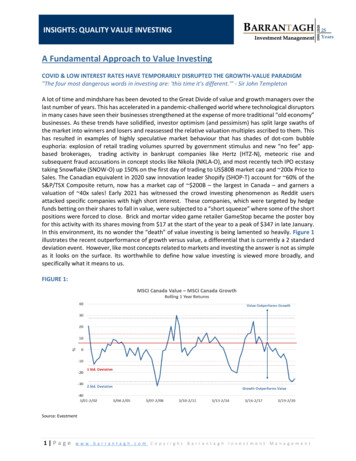
Transcription
Sustainable Corn: RecognitionCropping Systems Coordinated Agricultural Project(CSCAP): Climate Change, Mitigation, andAdaptation in Corn-based Cropping Systems2014Investing in Science, Securing Our Future. NIFA2014 Impacts ReportClimate Change, Mitigation, and Adaptation in Corn-based Cropping SystemsFollow this and additional works at: http://lib.dr.iastate.edu/sustainablecorn recognitionRecommended CitationClimate Change, Mitigation, and Adaptation in Corn-based Cropping Systems, "Investing in Science, Securing Our Future. NIFA 2014Impacts Report" (2014). Sustainable Corn: Recognition. 3.http://lib.dr.iastate.edu/sustainablecorn recognition/3This Article is brought to you for free and open access by the Cropping Systems Coordinated Agricultural Project (CSCAP): Climate Change,Mitigation, and Adaptation in Corn-based Cropping Systems at Iowa State University Digital Repository. It has been accepted for inclusion inSustainable Corn: Recognition by an authorized administrator of Iowa State University Digital Repository. For more information, please contactdigirep@iastate.edu.
United StatesDepartment ofAgricultureNational Instituteof Foodand Agricultureimpactsnational institute of food and agriculture2014 impacts reportinvesting in science securing our future www.nifa.usda.gov
nifa 2014 impacts reportthe U.S. Departmentof Agriculture’s National Institute of Food and Agriculture (NIFA) seeksinnovative solutions to issues related to agriculture, food, the environment,and communities. By supporting research, education, and Cooperative Extensionprograms at land-grant universities and other partner organizations, NIFA movesscience from labs to farms and classrooms, to the dining table, and back again.NIFA provides program leadership and more than 1 billion of congressionallyappropriated funding each year. NIFA’s mission, vision, goals, and initiatives arelinked to the strategic goals and priorities of USDA and the Research, Education,and Economics (REE) Action Plan. The resulting scientific progress enhances thecompetitiveness of American agriculture, bolsters the U.S. economy, enhancesthe safety of the nation’s food supply, improves the nutrition and well-being ofAmerican citizens, and sustains the nation’s environment and natural resources.NIFA grants also help institutions address shortfalls in curricula design, materialdevelopment, faculty enhancement, instruction delivery systems, studentexperiential learning opportunities, scientific instrumentation for teaching,and student recruitment and retention.The following projects highlight how NIFA-funding contributes to significantachievements in food, agricultural, natural resources, and human sciences.s a leader in food and agricultural sciences,10.9%16.2%Crop and Animal Production16.2%Goal 1B:Crop and Animal Health16.2%Crop and Animal Genetics, Genomics,Genetic Resources, and Biotechnology5.7%Goal 1D: Consumer and Industry Outreach,Policy, Markets, and Trade9.4%Goal 1C:3.9%16.2%14.6%Goal 1A:Goal 2A:Responding to Climate Variability5.5%Goal 2B:Bioenergy/Biofuels and Biobased Products5.0%Goal 3A:Water Availability: Quality and Quantity2.8%Goal 3B: Landscape-Scale Conservationand Management5.7%6.2%2.8%5% 5.5%9.4%6.2%Goal 4:Nutrition and Childhood Obesity14.6%Goal 5:Food Safety3.9%Goal 6:Education and Science Literacy3.6%Goal 7: Rural Prosperity/Rural-Urban Interdependence10.9%Total fy12 funding by ree goal100%Genetics may improve howcattle process nutrientsAnimal science researchers at the Universityof Missouri are working to improve feedefficiency in beef cattle. Investigators havelocated the chromosomal regions responsiblefor growth performance that help cattle getthe most out of what they eat. Armed withthis knowledge, cattle producers will be ableto build their herds by selecting and breedingstock that best possess this trait. These“feed conversion” genes are located ondifferent chromosomes in different breeds,so herd improvement selection criteria willvary by breed. By increasing the nutritionalefficiency of their herds, cattle producerswill see higher profits by reducing the amountof feed it takes to raise cattle. This will alsoreduce the environmental footprint of beefproduction by reducing amount of manureand greenhouse gases.Blueberries pass peaches in GeorgiaUniversity of Georgia horticulturists havedeveloped several varieties of blueberries thatare specialized as early- and late-seasoncrops, as well as larger berries at a higheryield. As a result, Georgia peaches have takena backseat as blueberry production hasincreased from 3,500 acres to more than20,000 acres in recent years. With annualfarm gate values approaching 254 million,the blueberry has become Georgia’s numberone fruit crop. In addition to improving yield,this research project included additionalmechanical harvesting, reducing commercialproduction time to 3 years or less, and developing sound harvest management practices. USDA photo by Scott Bauernifa funding by ree goal3.6% Photo by Mississippi State University Extension ServiceAfresh lettuce for consumers, and reducedgreenhouse gas emissions.local and global food supplyand securityHeating up lettuce productionLettuce contains a gene that halts seedgermination if it gets too hot, and that couldbe trouble in California and Arizona—twostates that produce more than 90 percentof the lettuce grown in the United States.Researchers at the University of CaliforniaDavis discovered a chromosome in wildPeruvian lettuce that allows for germinationat higher temperatures and transferred thatgene into commercial lettuce. The result is lesswater used to cool the soil, a longer growingseason, and a reduced need for shipping—a combination that means more water forother uses, more money for farmers, moreresponding to climateand energy needsResearch team works to sustaincorn through weather extremesAmerican corn production covers about 95million acres on 400,000 farms and broughtin about 65 billion in 2013. Those numbersare impressive, and NIFA has provided 20million in funding to sustain one of the nation’scontinued next page 3
sustainable use of natural resourcesUSDA Photo Green energy alternatives:From stable waste to power sourceUSDA PhotoUniversity of Nebraska researchers havedemonstrated that reduced tillage or no-tillfarming can save on irrigation. The researchersdetermined that farm plots with cover cropsor crop residue saved on irrigation water by asmuch as 60 to 110 millimeters per year, whichsaved farmers thousands of dollars per yearon a 130-acre field. In these days of prolongeddrought and severe wildfires across muchof the United States, the practice of covercropping and reduced-till agriculture can savefarmers money in reduced pumping costs andleaves more water available for other uses. 4Prosperity Organic Foods, Boise, ID, used aNIFA-administered Small Business InnovationResearch (SBIR) grant to develop an organic,healthy baking/cooking fat that raises energyexpenditure to assist with healthy, sustainableweight management. The organic baking/cooking fat was derived from an organicbuttery spread that is already in distributionin North America. The organic baking/cookingfat will be the first product line of its kindlaunched into the existing butter and margarine category to compete directly with nonspread forms of butter and shortening. Thecompany has been awarded an SBIR Phase IIgrant, which allows them to conduct furtherresearch and development and prepare forproduct commercialization. Camden Grows: A CommunityFood Projects success storyThe Community Food Projects CompetitiveGrant Program provides funds to low-incomecommunity, non-profit organizations thatdevelop projects to combat food insecurity,the state of having limited access to adequatefood. These projects help communitiesprovide for their own food needs and createnew marketing opportunities that helpboth agricultural producers and low-incomeconsumers. One such project, “CamdenGrows,” produces and distributes freshproduce to the residents of Camden, NJ—documented as the poorest city of its size inAmerica. Camden Grows helps communitygardeners who grow surpluses to sell theirproduce in the city. Gardeners in Camden Cover crops save irrigationwater and expenseMorrisville (NY) State College has putthe spurs to turning waste into sourcesof renewable energy. Researchers atInventing healthier fatsUSDA grantee photomost important farm crops through weatherextremes. Iowa State University is leading awide range of researchers from 10 land-grantuniversities and USDA’s Agricultural ResearchService in a Sustainable Corn Project tomitigate and adapt the Midwest “Corn Belt”to climate change. Since the project beganin 2011, researchers have created a centraldatabase to better evaluate how drainage,cover crops, tillage, fertilizers, and croprotations affect water, carbon, and nitrogencycles under variable weather conditions.In addition, the team is training 159 students—undergraduate through post-doctoral—to become the next generation of scientistswho can help increase future food productionand ensure the integrity and resilience ofnatural resources.during soy protein manufacturing. They knewthat if they found a way to remove the sulfurcontaining odorants they could improve theflavor of soy-based products and promoteconsumer demand. The team discoveredthat the addition of an approved food additivecalled potassium iodate during the manufacturing process stopped a chemical reactionwithin the soybeans and practically eliminatedthe foul odor. The technology of this process,which has been patented and is undergoingtrials in a large U.S. soy processing plant,is an example of how basic research fundedby a NIFA competitive grants program hasbeen transferred to private industry.nutrition and childhood obesityiStock photoPhoto by Stephanie EngleMorrisville’s Renewable Energy TrainingCenter have discovered a way to converthorse manure and bedding into briquettesand then use those briquettes as fuel to heattwo of the school’s residence halls. Producingthese briquettes is only a portion of themulti-million dollar grant, which funds thestudy of renewable energy sources, includingsolar and wind systems. The availabilityof horse manure and bedding material atMorrisville creates a “green” solution to therising cost of fuel production, saves moneythe school used to spend in disposal costs,and gives students a living laboratory toaccompany classes in renewable energyand sustainability.iStock photoImproving the quality of soy flavorUniversity of Kentucky researchers tookon the task of sniffing out and removing thesource of the unpleasant odors producedcontinued next page 5
produced more than 2.3 million in produceon more than 27 acres in the city, offeringfresh food to at least 15 percent of the city’s76,000 residents. Participants are growing30 fruit trees and almost 500 square feetof berry bushes, with more to be plantedthis year.education and science literacyGrowing numbers of femalefarm operators make timingright for Annie’s ProjectNorth Carolina A&T researchmakes peanuts safer to eatNovel pasteurization systemhelps keep food safePeanuts are the 12th most valuable cash cropin the United States. Allergies to peanuts areamong the most severe of all food allergies,affecting some 2.8 million people in the UnitedStates, including 400,000 school-agedchildren. Now, however, there is good newsfrom the North Carolina Agricultural andTechnical State University (NC A&T) wherescientists have discovered a way to removeup to 98 percent of the allergens. ResearchersA new microwave system developed byNIFA-funded researchers at Washington StateUniversity is now available to food companiesto help reduce the chances of contaminationin chilled or frozen meals. The microwaveassisted pasteurization system processes 8to 20-ounce pre-packaged chilled meals. Shelflife exceeding 1 month at refrigeration temperatures are possible. The potential applications of this technology extends to controllingpathogens on fresh and minimally processedfruits and vegetables using lower temperaturepasteurization and sophisticated packaging. Middle school students get“hands on” food safety educationiStock photoUniversity of Tennessee educators havedeveloped a food safety education curriculumfor middle school students entitled “HandsOn: Real World Lessons for Middle SchoolClassrooms.” Hands On is a free, interactive,research-based program that integratesscience, social studies, math, language arts,and vocabulary that teaches students key foodsafety concepts and practices. Foodborneillnesses cause an average of 5,000 deaths peryear and costing up to 37 billion per year inhealth care costs. Since adolescents frequentlyprepare after-school snacks, and even meals,it is important for them to receive this training.As of March 2013, Hands On has reachedmore than 34,000 students at 148 middleschools in 11 states.found that by soaking roasted peanuts thathave been shelled and skinned in a solutioncontaining food-grade enzymes, they canvirtually reduce or eliminate two key allergens.The process does not affect flavor, and treatedpeanuts can be eaten whole, in pieces, or asflour in various products. The process hasbeen validated at the University of NorthCarolina at Chapel Hill through human clinicaltrials using skin prick tests. NC A&T officialsexpect hypoallergenic peanut products to hitstore shelves soon. USDA photofood safetyHelping Afghans strengthentheir extension capacityWith NIFA-administered funding andcollaboration from USDA’s Foreign Agricultural Service, the University of CaliforniaDavis is leading a consortium of Americanuniversities (Purdue, Washington State,and University of Maryland) that is helpingto strengthen the extension education systemin Afghanistan. The Afghanistan AgriculturalExtension Project (AAEP) initiated provincialmodel teaching farms, farmer field schoolsand on-farm demonstrations—now maintained and supervised by Afghan extensioneducators—to cover such topics as womenin agriculture, greenhouse production,conservation agriculture, and improved grainstorage methods to reduce postharvest loss.AAEP has trained nearly 8,000 extensioneducators, agricultural faculty, students andfarmers and established more than 600farmer field schools in 19 Afghan provincessince 2012.iStock photoiStock photo Annie’s Project, an education program thatis dedicated to empowering women inagriculture, develops the networks and skillswomen need to form successful partnerships.Across America, Annie’s Project coursesprovide women in agriculture with answers,business skills, friendship,and confidence.The number of women owning farm businesses or becoming more involved in farmdecision-making is growing nationally.For example, in New York’s ChautauguaCounty, 228 women, or 16 percent, areprimary farm operators according to the 2007Census of Agriculture. Women farm owners/operators are on the rise, with a 3 percentincrease from 2002 to 2007 in ChautauquaCounty. These women don’t have to go italone, as Cornell Cooperative Extensionfacilitates Annie’s Project in New York andoffers a 6-week program in risk management,farm business planning, marketing, andmore. rural prosperity/rural-urban interdependence Teaching the next generation ofAmerica’s farmers and ranchersA team from the University of Arkansas usedfunding from NIFA’s Beginning Farmer andRancher Development Program to developonline educational modules and in-persontraining and mentoring to underserved groups. 6continued next page 7
Photo by University of ArkansasProject educators teach poultry, livestock,and agroforestry production to militaryveterans, Spanish-speaking individuals,women in agriculture, African-Americans,and economically and educationallydisadvantaged groups. The team of university,non-profit, and USDA scientists trainedapproximately 300 veterans in the region,plus 650 veterans nationally through theFarmer Veteran Coalition. A total of 26,823people used the online training—16,059in English and 10,764 in Spanish. Evaluationsshowed that participants are using allmodules, the most popular being poultryproduction and business development.now provides over 100 jobs in rural Louisiana.Sweet potatoes are an important crop forsmall farmers in Louisiana and neighboringstates, and small-farm sector sweet potatoesare bringing higher prices. On a broader scale,multistate research funding from NIFA supports the National Sweetpotato CollaboratorsConference, a group that since 1939 hasexchanged information about all aspectsof sweet potato production and post-harvestresearch and extension. Conference researchers have released 94 new sweet potatovarieties that have been adopted worldwide. Creating productivity, jobs, andnutrition through sweet potatoesUSDA photo by Lance CheungLouisiana State University researchers havedeveloped new varieties of sweet potatoesthat are more disease and pest-resistent.As a result, sweet potato yields have increasedby more than 20 percent and a new processing plant was constructed for high-qualityfrozen sweet potato products—a plant thatINVESTING IN SCIENCE SECURING OUR FUTURE WWW.NIFA.USDA.GOVUSDA is an equal opportunity provider and employer June 2014
3 nifa funding by ree goal Goal 1a: Crop and Animal Production 16.2% Goal 1B: Crop and Animal Health 16.2% Goal 1c: Crop and Animal Genetics, Genomics, Genetic Resources, and Biotechnology 5.7% Goal 1D: Consumer and Industry Outreach, Policy, Markets, and Trade 9.4% Goal 2a: Responding to Climate Variability 5.5% Goal 2B: Bioenergy/Biofuels and Biobased Products 5.0%











